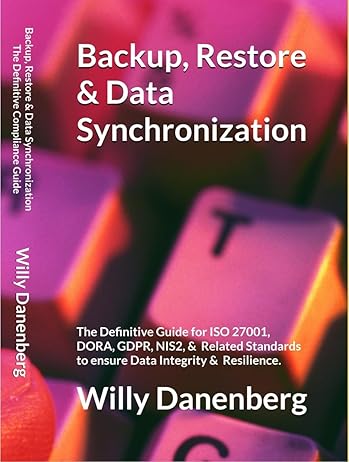Backup, Restore & Data Synchronization – The Definitive Guide to Enterprise Data Resilience

Introduction
In today’s hyper-connected and compliance-driven digital world, data is no longer just an asset—it is the lifeblood of every enterprise. Whether you are a multinational bank, a healthcare provider, a government agency, or a fast-growing fintech, your ability to protect, restore, and synchronize data determines not only your resilience but also your survival.
This is the exact premise of Willy Danenberg’s groundbreaking book Backup, Restore & Data Synchronization—a 434-page strategic and technical blueprint that equips organizations with the tools, processes, and cultural mindset needed to turn data protection into a strategic advantage.
Published by PayServices BV in February 2025, the book has already become an essential reference for IT architects, data engineers, compliance officers, and business leaders worldwide.
About the Author – Willy Danenberg
Willy Danenberg is known for his practical approach to complex regulatory and technical frameworks. His books span from regulatory clarity (EU Directive DORA Made Simple) to deeply technical explorations of IT resilience.
With this volume, he merges real-world technical depth with strategic foresight, providing a guide that speaks equally to:
- Data architects designing infrastructures.
- Compliance officers navigating ISO 27001, GDPR, DORA, and NIS2.
- Executives seeking business continuity assurances.
- Security engineers protecting critical systems.
Why This Book Matters Now
The stakes for data resilience have never been higher:
- Cyber threats like ransomware attacks are increasing in scale and sophistication.
- Regulatory frameworks such as ISO 27001, GDPR, NIS2, and DORA are demanding higher standards of compliance.
- Digital transformation initiatives have introduced hybrid cloud, microservices, and distributed data ecosystems that complicate data management.
- Downtime costs are skyrocketing, with global studies estimating millions lost per hour of critical system outages.
This book doesn’t just offer “best practices”—it delivers a complete survival strategy for the digital era.
Book Details
- Title: Backup, Restore & Data Synchronization
- Author: Willy Danenberg
- Publisher: PayServices BV
- Publication Date: February 27, 2025
- Language: English
- Pages: 434
- Formats: Kindle / Paperback / Hardcover
- ISBN: 979-8897664146 (Kindle: B0DYW7BCH4)
- Amazon Link: Backup, Restore & Data Synchronization
Core Themes and Coverage
- a) Precision Backup Engineering
- Goes far beyond basic backup strategies.
- Explores immutable storage, hybrid-cloud backups, and real-time replication.
- Teaches how to design architectures tailored to your application ecosystem.
- b) Zero-Downtime Restoration
- Focuses on reducing RTO (Recovery Time Objective) and RPO (Recovery Point Objective).
- Provides methodologies for orchestrating rapid recovery.
- Covers catastrophic failure scenarios and continuous business operations.
- c) Intelligent Data Synchronization
- Ensures absolute data consistency across systems.
- Explains change data capture (CDC) and advanced synchronization protocols.
- Guides you in data pipeline engineering for large-scale, heterogeneous environments.
- d) Real-World Case Studies
- Breaks down actual data disasters.
- Shows root causes, response strategies, and lessons learned.
- Provides cautionary tales to prevent repeating mistakes.
- e) Regulatory Alignment
- Helps organizations map resilience strategies to compliance obligations.
- Covers ISO 27001, GDPR, DORA, NIS2, and related standards.
- Turns compliance from a burden into a competitive advantage.
- f) Data Management Team (DMT) Empowerment
- Outlines how to structure and lead an effective data resilience team.
- Defines roles, responsibilities, and workflows.
- Encourages a culture of proactive monitoring and resilience.
Key Takeaways for Readers
By the end of this book, readers will be able to:
- Engineer sophisticated backup systems that go beyond “nightly snapshots.”
- Restore data instantly with minimal business disruption.
- Synchronize data globally across on-premises, hybrid, and cloud-native environments.
- Meet and exceed compliance with modern regulations.
- Anticipate and prevent disasters with proactive resilience strategies.
- Build high-performance teams that own and optimize data resilience.
Who Should Read This Book?
- CIOs & CTOs – to develop enterprise-wide resilience strategies.
- Data Architects – to design high-availability infrastructures.
- IT Security Teams – to strengthen cyber recovery readiness.
- Compliance Officers – to align data practices with GDPR, DORA, ISO 27001, and NIS2.
- Business Leaders – to protect operations, reputation, and customer trust.
It’s especially valuable for organizations in finance, healthcare, government, e-commerce, and critical infrastructure.
Why This Book Stands Out
Unlike many technical guides, this book bridges:
- Theory and Practice – providing hands-on methodologies and not just conceptual frameworks.
- Technology and Compliance – uniting technical resilience with legal/regulatory mandates.
- People and Culture – emphasizing that resilience isn’t only systems, but also teams and processes.
It is not a vendor manual—it’s a vendor-neutral strategy playbook.
Deep Dive into Key Chapters
Chapter 1 – The Data Fortress Mindset
Introduces why organizations must treat data as a strategic fortress, not a utility.
Chapter 2 – Precision Backup Engineering
Explains design patterns for modern backup infrastructures, covering cloud-native and hybrid solutions.
Chapter 3 – Zero-Downtime Restoration
Details how to design instant recovery processes that eliminate costly downtime.
Chapter 4 – Intelligent Synchronization
Covers global replication, CDC pipelines, and integrity assurance.
Chapter 5 – Regulatory Maze Navigation
Maps compliance strategies to ISO 27001, GDPR, DORA, and NIS2.
Chapter 6 – Lessons from Real-World Disasters
Presents case studies with failures and best-in-class responses.
Chapter 7 – Building the Data Management Team (DMT)
Provides a framework for creating efficient, resilient teams.
Chapter 8 – Proactive Resilience Culture
Focuses on monitoring, automation, and continuous improvement.
Real-World Relevance – Why Enterprises Need This Book
- Ransomware resilience – Immutable backups and zero-trust strategies.
- Cloud migration – Synchronizing data across hybrid environments.
- Mergers & Acquisitions – Ensuring consistent data pipelines across entities.
- Regulatory audits – Demonstrating compliance readiness.
- Global operations – Coordinating resilience across geographies.
Strengths of the Book
- Comprehensive at 434 pages yet structured for clarity.
- Balances deep technical detail with strategic foresight.
- Uses real-world disasters and case studies.
- Offers actionable frameworks—not just abstract ideas.
- Speaks to both technical and non-technical audiences.
Why You Need This Book
The data resilience landscape is changing fast:
- Cyber incidents are now considered when, not if.
- Regulators are demanding proof of resilience, not just policies.
- Customers expect uninterrupted digital services.
- Executives can no longer delegate resilience to IT—it’s a board-level priority.
This book prepares you for all of these challenges.
Final Thoughts
Backup, Restore & Data Synchronization isn’t just a manual—it’s a strategic weapon for digital survival. Willy Danenberg equips enterprises to transform their data infrastructure from a potential liability into an unshakable competitive asset.
If you are serious about business continuity, compliance, and resilience, this is the book you need in 2025.
👉 Order your copy today and take the first step toward bulletproofing your data future.
Frequently Asked Questions (FAQ)
Q1: Is this book highly technical?
Yes and no. It dives deep into technical architectures but balances this with strategic and compliance insights.
Q2: Is it relevant for small businesses or only large enterprises?
Both. The principles apply at all scales, though larger organizations will benefit most from the comprehensive frameworks.
Q3: Does it cover cloud-specific strategies?
Yes. It covers hybrid-cloud, multi-cloud, and cloud-native backup and synchronization.
Q4: How does it address compliance?
It aligns strategies with ISO 27001, GDPR, NIS2, and DORA, making regulatory audits easier.
Q5: Does it include disaster recovery scenarios?
Yes. Detailed case studies illustrate how to prevent and recover from disasters.
